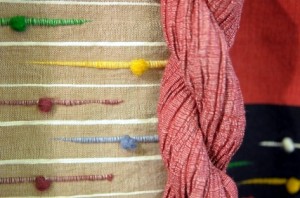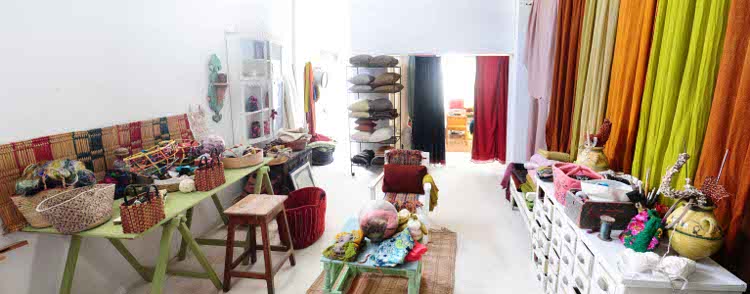
History as left well recognizable reminders across the whole of the Maghrib in the shape of the wide variety of textiles used and dresses worn. Also in Tunisia, textiles, their significance and methods of production remain a firm part of the country’s identity. Tunisians knot and weave rugs, weave cloths of rural, urban, sub-Saharan traditions that were influenced throughout their history by the Greek, Andalusian, Otoman and Arabic civilisations; they dye their fibres and fabrics with the essence of henna, madder and pomegranate’s bark that result in a rich gamut of earthy yellows, browns, greens and reds; and they embroider intricate decorations that one day will be part of a wedding dress, or exquisite curtains, or decorative bed throw. The country’s textile heritage vibrates with the diversity: that arising from the gender segregation between men and women; and that arising from the differences between rural areas and the cities, the islands and the desert, the hinterlands and the central market towns. And, while there is some silk weaving surviving, when it comes to textiles, in Tunisia it is all about wool. To the extent that over the centuries a type of sheep with a soft long staple fleece has been bred that now proudly carries by name the country’s capital Tunis into the world.
The historic influence of civilisations past is well visible also in the variety of weaving technologies predominant in different regions. Upright, single-heddle looms are used by women in rural areas of the country, and date back to antiquity. The horizontal ground looms used in the same regions were introduced following the Arab invasions of the seventh century AD. Treadle-loom weaving was introduced during the eighth century, although the varieties of treadle loom used in Tunisian towns such as Mahdia probably did not become widespread until the period of Ottoman influence from the sixteenth century onwards. Finally, draw-looms – invented in Spain or Portugal, and named after the set of supplementary heddles that would be “drawn up” by one or more assistants to the weaver – are still used in Mahdia to weave a rare type of narrow silk strips in complex patterns.
And on the island of Djerba the weaving trade was considered so important for the local economy that dedicated weaving huts, called harout, were built next to a weaver’s home. Whitewashed, with its two triangular pediments, front and back, and its sunken external buttresses down each side, a harout is easily recognizable. Yet – the finest Djerban textiles, in particular the intricately patterned Biskri, are not always woven in the harout, but rather in a back room of the weaver’s own home.
On Kerkennah, a group of islands further South from Djerba, the men weave plain coloured cloth which then are decorated by the women with counted thread embroideries that date as far back as the Carthaginians. But, like in many places removed from the city centres, Kerkennah suffers from an exodus of young people to the larger cities, a lack of opportunities for income generation, and an ageing local population. As a result, the typical Kerkennian weaving and embroidery is close to extinction. With this in mind, Farma Samet, a native from the island and herself a skilled weaver and passionate weaving student and teacher, founded Kerkenatiss. Under the company’s wings, a network of weavers and embroiderers transforms natural fibres – in addition to wool, fibres such as camel hair are used for texture – into a wide range of fabrics suitable for interiors or clothing. The network approach has changed lives. Not only do the sales generate much needed income for the communities, but even the national crafts organisation has become aware of the wealth of textile knowledge that exists across the country and which is in desperate need of recording and preservation.
In a similar pursuit Mariem Besbes has turned from a professional dancer into an expert in plant dyes and openwork weaving of wool gauze cloth, a fabric which still is used for the traditional Tunisian haik, a women’s full-body veil. When used as curtains, the cloth’s semi-transparent and heavy texture screens the residents from the eyes of pass-byers, yet allows them to see through to the outside. And its precisely this characteristic, combined with the warm, earthen yellow and red tones of the plant dyes that gives the fabric a distinct northern African yet modern and homey feel, which make the it by design perfectly suitable for interiors.



